Surviving in the swiftly-evolving retail market is a bigger challenge now than ever before, even for industry giants like Target and eBay. Both companies announced recently that they will be putting an added focus on their online presence, though each will be implementing it in their own way.
Major Retailers Shifting Strategy
Target now uses their retail locations as fulfillment centers for their online orders—a practice which now covers around 55% of all online business. They also plan to redesign some of their stores in order to better meet the needs of the modern consumer. The company announced that they will be allocating $7 billion to address these two initiatives in the coming year. Target’s internal data shows that roughly half of all Americans live less than five miles away from a Target location, so using those properties to assist with distribution for online orders might give them an advantage over non-brick and mortar companies. Final-mile delivery is key to meeting the delivery expectations consistent with retail industry trends, and having mini-fulfillment centers within a short radius of more than half the population could be a considerable advantage.
This industry shift towards online shopping isn’t lost on eBay CEO Devin Wenig, who believes that brick and mortar retailers need to adapt to the online marketplace or risk being phased out. In an interview with CNBC, he mentioned that he doesn’t think stores will vanish completely, but he gives the advantage to those who follow the “mini distribution center” model like Target. eBay is also making changes in an attempt to remain competitive with other online retailers, announcing their plans to promise 3-day delivery on over 20 million products this summer.
Looking Ahead at Retail Industry Trends
This progression suggests that the focus will be on fast, efficient shipping in order to keep customers satisfied and loyal. Amazon’s consistent two-day shipping has created market-wide consumer expectations, forcing competitors to step up their game. Brick and mortar retailers ramping up their online presence and using their existing resources for more efficient shipping—as well as more ambitious shipping promises—suggests that these companies are rethinking the way they move products through their supply chains.
Essentially, supply chain visibility is becoming more crucial than ever before. Companies who can manage their inventory—who know where their inventory is at all times—and consistently live up to delivery promises will maintain an advantage over their competitors. It sounds straightforward and obvious, but with the antiquated nature of EDI technology, supply chain visibility and communication experience quite a bit of lag. Companies hoping to provide themselves with a leg up will have to look into newer technology for the supply chain.
It’s a transitional period for brick and mortar retailers. The next few years are going to be pivotal for even established brands, and developments in logistics technology are going to be the deciding factor in who leads the charge, and who gets left behind. Those who leverage new logistics technology solutions will succeed and flourish while those who attempt to maintain the status quo will fade into obscurity.



